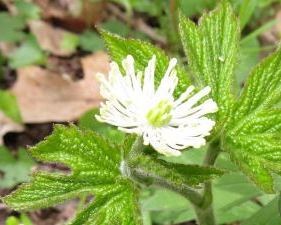Orangeroot
(Trautvetteria carolinensis)

Description
Goldenseal (Hydrastis canadensis), also called orangeroot or yellow puccoon, is a perennial herb in the buttercup family Ranunculaceae, native to southeastern Canada and the eastern United States. It may be distinguished by its thick, yellow knotted rootstock. The stem is purplish and hairy above ground and yellow below ground where it connects to the yellow rhizome. Goldenseal reproduces both clonally through the rhizome and sexually, with clonal division more frequent than asexual reproduction. It takes between 4 and 5 years for a plant to reach sexual maturity, i.e. the point at which it produces flowers. Plants in the first stage, when the seed erupts and cotyledons emerge, can remain in this state one or more years. The second vegetative stage occurs during years two and three (and sometimes longer) and is characterized by the development of a single leaf and absence of a well developed stem. Finally, the third stage is reproductive, at which point flowering and fruiting occurs. This last stage takes between 4 and 5 years to develop. A second species from Japan, previously listed as Hydrastis palmatum, is now usually classified in another genus, as Glaucidium palmatum. Hydrastis canadensis is a herbaceous perennial growing from a horizontal, yellowish rhizome that is thick with knobby knots. The finely hairy, upright, unbranched, stems grow 5"-15", 15–50 cm tall. Fertile plants have a single stem with two palmately lobed leaves. Flowering plants produce a single terminal flower with no petals and three sepals and twelve or more conspicuous white pistils; flowering occurs for a short time in spring. Fertilized flowers grow into red, raspberry-like fruits with one or two seeds. Hydrastis canadensis grows in mesic forests under deciduous trees. It is found in sheltered ravines or on talus slopes. It seems to be intolerant of disturbances in the tree canopy and grazing. It can be found growing in association with other uncommon plants such as Jeffersonia diphylla (twinleaf) and Dicentra canadensis (squirrel-corn). According to the American Cancer Society, "Available scientific evidence does not support claims that goldenseal is effective in treating cancer or other diseases. Goldenseal can have toxic side effects, and high doses can cause death. According to the National Center for Complementary and Integrative Health, "The scientific evidence does not support the use of goldenseal for any health-related purpose."
Taxonomic tree:







